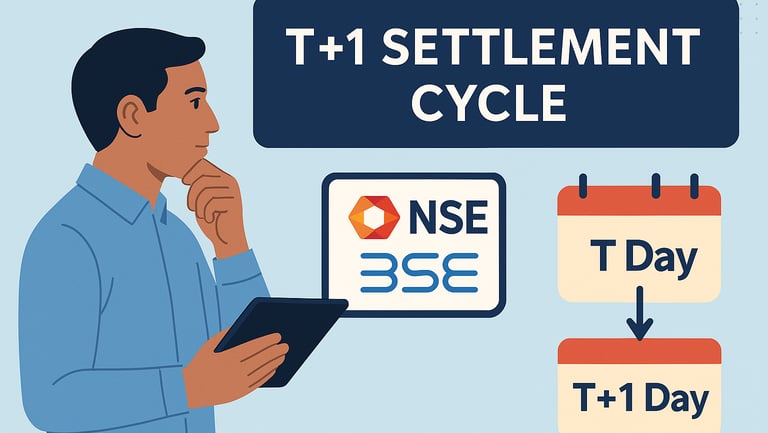What is T+1 Settlement in the Indian Stock Market? 2025 | Stock Market Help
If you've ever wondered how long it takes to receive your shares or money after placing a trade—you're not alone. The answer lies in the “settlement cycle.” And in 2023, India made a big leap forward by moving to the T+1 settlement cycle india. Stock Market Help
Stock Market Help
4/14/20252 min read


What is T+1 Settlement in the Indian Stock Market? [2024 Guide for Beginners]
If you've ever wondered how long it takes to receive your shares or money after placing a trade—you're not alone. The answer lies in the “settlement cycle.” And in 2023, India made a big leap forward by moving to the T+1 settlement cycle.
Let’s break it down in simple terms and explore why this matters to investors and traders alike.
📌 What is a Settlement Cycle in the Stock Market?
The settlement cycle refers to the time it takes for a trade to be completed—i.e., for shares to be delivered to the buyer and money to be transferred to the seller.
In simpler words:
You buy a stock today, but when does it actually show up in your Demat account? That’s what the settlement cycle determines.
⏱️ What is T+1 Settlement?
✅ Meaning of “T” and “+1”
T stands for the Trade date—the day on which the buy or sell order is executed.
+1 means that the trade will be settled one business day after the trade date.
For example:
If you buy a stock on Monday, you’ll receive the shares in your Demat account by Tuesday (T+1).
🕓 Timeline of T+1 Trade Settlement:
ActivityDayTrade ExecutedT (e.g., Monday)Settlement CompletedT+1 (e.g., Tuesday)
🔁 T+2 vs T+1: What Changed in 2023?
🕰️ Historical Context
Before 2023, India followed the T+2 settlement cycle, meaning it took two business days to settle trades. This was standard globally.
🇮🇳 Why Did SEBI Move to T+1?
The Securities and Exchange Board of India (SEBI) initiated the shift to:
Increase liquidity
Lower systemic risk
Make Indian markets more efficient and investor-friendly
📈 Which Exchanges Adopted T+1?
NSE (National Stock Exchange)
BSE (Bombay Stock Exchange)
By January 2023, all listed stocks on both exchanges transitioned to T+1 settlement.
🤔 How Does T+1 Settlement Affect You?
👨💼 For Delivery-Based Traders
Faster access to shares/funds after a trade.
You can reinvest funds quicker, boosting capital efficiency.
⚡ For Intraday Traders
Intraday trades settle on the same day (T), so T+1 has minimal impact.
However, if your intraday trade converts to delivery, T+1 applies.
🏦 For Brokers & Institutions
Need to process trades faster
May require upgraded infrastructure to manage one-day settlements
✅ Benefits & Challenges of T+1
👍 Benefits:
Faster liquidity for investors
Lower counterparty risk
Makes India one of the fastest-settlement markets globally
Aligns with digital push and global best practices
👎 Challenges:
Operational pressure on brokers and clearing houses
Foreign investors in different time zones may face difficulties
❓ FAQs
📌 Is intraday trading affected by T+1?
No. Intraday trades are squared off the same day. T+1 applies only if your trade turns into delivery.
📌 Can I sell shares before T+1 settlement?
Yes. You can sell shares before T+1 as brokers often allow BTST (Buy Today, Sell Tomorrow) trades. However, risks like auction penalties may apply if delivery fails.
🧠 Conclusion
The T+1 settlement system is a game-changer for Indian markets. It offers faster access to funds, reduces risk, and enhances trading efficiency. While it may pose challenges for brokers, the overall impact on investors is largely positive.
🔗 You Might Also Like:
💬 Got Questions?
Have thoughts or doubts about T+1 settlement? Drop them in the comments below 👇
And don’t forget to subscribe to our newsletter for simplified stock market insights!
Help Me Invest Solutions
Empowering Investors and traders since 2013 with expertise.
Contact us
© Copyright @2023-2025 HELP ME INVEST SOLUTIONS | All Rights Reserved
